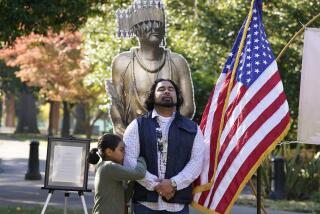âGive It Backâ for Tax Breaks : HEAD Indian Group Urging Land Donations
WASHINGTON â An American Indian group is promoting the idea, âGive it back to the Indians,â by urging people to donate land in exchange for hefty tax breaks.
The American Indian Heritage Foundation, a nonprofit charitable group, has placed ads in the Washington Post and aired public service announcements on Washington-area radio stations since last November in its campaign for land donations.
âGive it back to the Indians . . . and get a good tax break too,â proclaims the ads in the Post. The foundation, based in the Washington suburb of Falls Church, Va., also placed an ad in the Wall Street Journal last month.
Iron Eyes Cody
The radio spots feature Iron Eyes Cody, the stoic Indian remembered for his tears in the âKeep America Beautifulâ ads of a few years ago, and Princess Pale Moon, an Indian activist and recording artist who travels around the world promoting the culture and heritage of the American Indian.
Moon also heads the foundation, which sends Indian youths to summer camps, sponsors achievement awards in Indian schools and contributes money, clothing and blankets to Indian reservations, mission schools and Indian urban centers.
It also distributes turkeys at Thanksgiving and toys at Christmas to needy Indians around the country.
Since the ad campaign began in the Washington area, the foundation has received six pieces of property valued at about $300,000, said Pale Moonâs husband, Wil Rose.
Another $1.25 million worth of property, including a private school in Hagerstown, Md., and nearly three acres on Capitol Hill âis still in the wings,â added Rose, who has worked for many years with volunteer groups, including the United Way and the âPeople to Peopleâ program under President Dwight D. Eisenhower.
Rose said some of the donated properties may be sold to finance the foundationâs projects and others may be donated to Indian groups or retained for other purposes.
Internal Revenue Service regulations allow a taxpayer to donate property to any public charity and to deduct the fair market value, up to 30% of his adjusted gross income, from his income taxes.
If the property value exceeds that figure, the taxpayer can continue to deduct the donation for each of the next five years until the total value is written off--a significant tax shelter.
Rose conceded that some of the donated property falls into the âwhite elephantâ category--property the owners have found difficult to sell. But others are quite marketable.
âEach property has to be self-financing,â he said, meaning it must be readily salable or cost the foundation nothing to maintain.
Some Indians, including Suzanne Harjo of the National Congress of American Indians, one of the countryâs largest Indian groups, are critical of the campaign.
âIt makes far better sense to donate land or money to actual Indian nations or tribes,â said Harjo, who is of Cheyenne and Creek ancestry. âWe have myriad serious-to-critical problems in Indian country and we need everyoneâs serious help. Toys and books and turkeys are not going to solve our problems of rampant disease, unemployment and other problems that plague Indian country.â
Some of the more traditional Indian leaders criticize Pale Moon, who is not a full-blooded Indian, as an âApple Indianâ--one that is red on the outside and white on the inside.
âI wouldnât go that far,â Harjo said. But, she added, âIndians donât have princesses. We have no need of royalty. Itâs a scurrilous designation.â
Rose responded: âFor those trying to stop the clock or turn it back, weâre probably not admired.â But he said he does not agree with strict traditionalistsâ view that Indians should not mix with the âdominant culture.â
More to Read
Sign up for Essential California
The most important California stories and recommendations in your inbox every morning.
You may occasionally receive promotional content from the Los Angeles Times.










